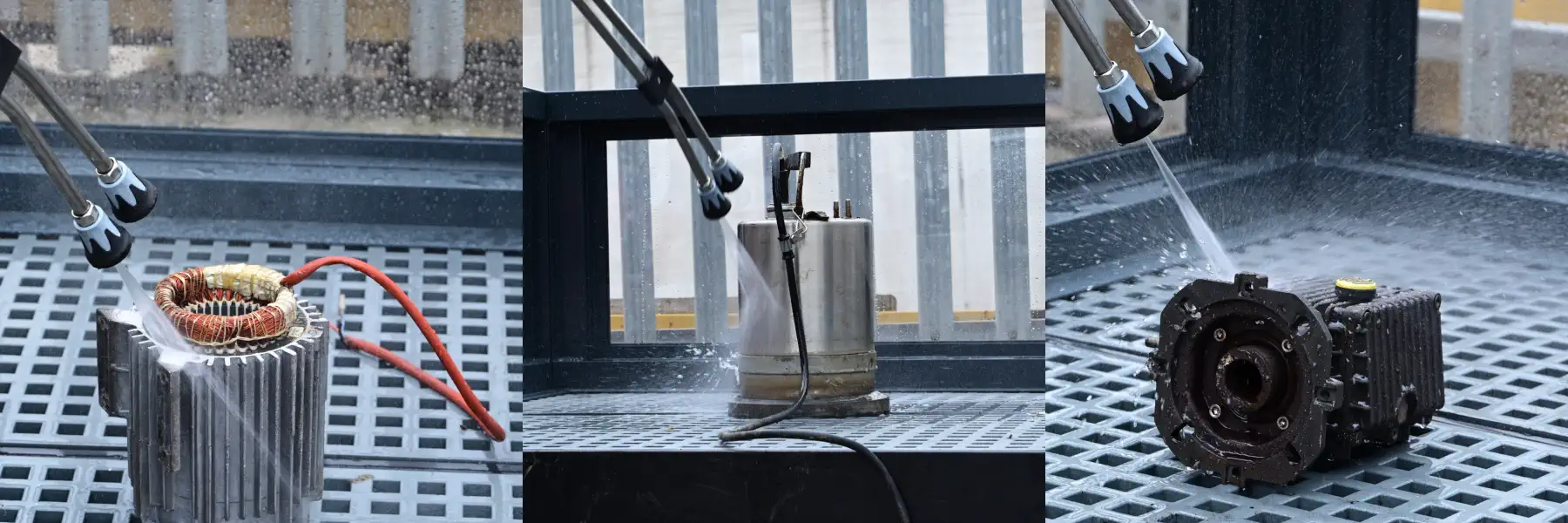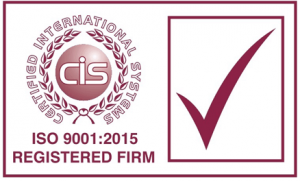Wash tank for cleaning parts of up to 3 tonnes

Utilising the wash tank as a jet washing enclosure for cleaning parts provides an ideal way of jet washing smaller items such as pumps, motors and other components. Your parts can be washed with a hot or cold jet wash, including our electrically heated range for zero emissions.
Generally installed with a 100mm to 150mm wash tank beneath, the unit is generally suitable as a standard supply for washing parts up to 3T in weight. The self-contained jet washer tank is made from polyethylene and the parts wash tank can be manufactured from 1M x 1M footprint and from 100mm depth up to 500mm depth.
The washing tank is usually surrounded by a splash screen on 3 sides to contain overspray and can be used internally.
Typically a small pump box is added to pump the water to an above ground interceptor, and then the effluent will outflow to a mains foul drain or sewer. The GRP gratings are all removable to enable debris and silt to be taken out.
The jet washing enclosure for cleaning parts is similar in design to the wash tanks in that the installation is all above ground and requires no excavation or ground works. The design means the jet washing enclosure is also semi-portable and can be relocated.
Also available with forklift pockets for total portability so that the self-contained unit can be moved around to any location.
- Polyethylene requires no painting or surface preparation, unlike steel.
- No rusting or deterioration of the surface due to marks and scratches
- No rusting of screws, bolts or seams where steel is welded
- Lighter to transport and maneuverer if relocated
- Resistant to chemicals and detergents
Click below to view our full product guide. (opens in a new window)
Morclean’s quality administration systems have been assured and approved to the standards and guidelines of BS EN ISO 9000:2015 for the sales, service and hire of industrial cleaning equipment.
Our registration no. is 94/121120 and our standards and guidelines are externally audited by CIS.
- Please note that many models described on this website are bespoke, and as such cannot always be accurately depicted.
- All photographs and illustrations displayed on this website are representative of model ranges or a model series only. Individual models and specifications may vary from those shown.
- Please contact us if you require clarification or individual specifications of any equipment. Morclean reserve the right to update and amend the specification of our equipment and accessories without notice and in the interest of the customer.
- Images or specifications must not be reproduced with express written consent from Morclean Ltd.
- Any prices quoted are subject to VAT @ SR. E &OE
YOUR LEGAL REQUIREMENTS, DUTY OF CARE AND COMPLIANCE
Effluent and run-off from washing and cleaning activities can damage the environment and pollute rivers, streams, burns and groundwater. Dirt, brake dust, traffic film residue and oil that is washed off are all pollutants.
The cleaning agents you use (including those labelled biodegradable or traffic film removers) are very poisonous to river life. If you cause pollution, you are breaking the law and spoiling your environment. Dirty water or run-off from vehicle washing and cleaning carried out as a business or industrial activity is called trade effluent.
Whether you’re cleaning just one vehicle or responsible for a large lorry fleet, you must arrange for collection and disposal of effluent to prevent pollution. It’s illegal to discharge trade effluent to the environment or into drains without permission.
A selection of general and typical requirements for the containment and safe disposal of wash water are shown below
Activities that produce run-off from the vehicle onto the ground and use cleaning and valeting products should be carried out in areas that are clearly marked and isolated from surface water drainage systems, unmade ground and porous surfaces. These areas are called designated washing bays. A designated washing bay should be designed so that run-off is:
- isolated using channels, gullies, gradient (fall on the surface) and kerbs
- directed to a silt trap or settlement tank to remove larger particles of silt and sediment
- either collected in a sealed system for reuse, discharged to the public foul sewer with prior permission of the local sewer provider or collected in a sealed system for authorised disposal
You should also:
- have procedures for everyone, including contractors, that cover where and how vehicle washing and cleaning should be carried out and what to do in a spillage emergency
- provide notices for designated washing bays saying what they’re for and that washing and cleaning should only be carried out in the bay • consider whether a fence or barrier is required to prevent spray or wind drift out of the designated area
- have procedures and equipment which minimises water use and solid waste production
Understanding your drainage system is the key to preventing pollution. Most areas have what is known as a separate drainage system where there are two types of drain:
- Surface water or clean water drains should only carry uncontaminated rainwater; they lead directly to ditches, streams, burns, rivers and soakaways. Roof water, car park, road and some yard drainage is usually connected to the surface water drainage system
- Foul water drains carry contaminated water (sewage and/or trade effluent) safely to a sewage treatment facility, which is either owned privately or by the local sewage treatment provider. Any system designed to carry foul water is called a foul water drainage system
- Drains (surface water and foul) are also known as sewers. Your local sewer provider is the organisation with the legal responsibility to provide public sewerage and sewage treatment facilities in your area. Drains owned by the local sewer provider are known as mains drainage, main sewers or public sewerage systems
The Morclean bunded wash tank provides a compliant solution, namely an isolated, bunded and water tight method for the containment of contaminated wash water.


